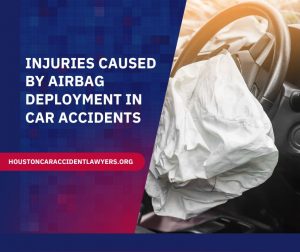Houston Car Accident Lawyers > Houston Car Accident Lawyer Reviews > Common Car Accident Injuries > Injuries Caused by Airbag Deployment in Car Accidents | Types of Injuries
Injuries Caused by Airbag Deployment in Car Accidents | Types of Injuries

Airbags are designed to save the life of car passengers, yet they can sometimes cause injury. If you were injured by an airbag in a car accident, you should investigate your legal options for compensation. Contact www.HoustonCarAccidentLawyers.org right now if you have been injured by an airbag that deployed improperly or dangerously.
Airbag Deployment Injuries Can Kill You

Airbags are implemented as a safety precaution in cars, to protect drivers and passengers during an accident. However, when faulty or poorly maintained they can cause serious harm – sometimes even resulting in death.
In this post we will explore how airbags work within vehicles; the injuries that may arise from malfunctioning ones; what you should do if such an incident occurs – plus more information on potential compensation for those affected by injured airbag cases .
What Happens When An Airbag Deploys
In the event of a high-speed collision, your car’s airbags are in place to protect you.
Located inside steering wheels and beneath dashboard panels as well as doors, lightweight materials form these cushions that inflate thanks to an argon or nitrogen gas released by a sensor triggered upon impact. A reliable safety solution for when accidents occur at speeds faster than 10 miles per hour!
How Fast Airbags Deploy
From a split second deployment to speeds of up to 200 miles per hour, airbags can be the difference between life and death. But in its wake lies an unpleasant aftermath – from burning eyes and skin irritation due to the release of chemicals, it’s important for drivers everywhere that they stay prepared for whatever comes their way on our roads.
All passenger vehicles have been required to feature frontal airbags since 1998. This implies that if your car was manufactured after 1998, it includes airbags in the front and most likely elsewhere throughout the vehicle.
How Airbag Deployment Injures Drivers During Accidents
Airbag technology has saved over 50,000 lives since 1987; however, it can still pose a serious risk when the collision sensor fails. In these cases, airbags may be activated too late or not at all during an accident – which could result in painful injuries for passengers whose heads are close to them upon deployment. We must continue researching and improving this integral safety feature of our vehicles to ensure that we improve upon its already impressive lifesaving capabilities while reducing potential accidents stemming from faulty sensors.
The Most Common Airbag Injuries
When an airbag deploys, it can result in a number of injuries. These injuries can occur anywhere on the body, depending on where the passenger is sitting and how close they are to the airbag when it deploys.
The following are the most common forms of injuries associated with airbags:
- sprained fingers and wrists, as well as various hand injuries
- injury to the eyes
- lacerations and abrasions
- contusions on numerous body parts, including the chest, arms, face, and legs
- organ injuries, brain injury, and head injury
- internal bruising
- harm to different internal organs such as the liver, veins, and lungs
- concussions
- swelling of the brain
- consciousness loss
- bruises on the body parts that came into contact with the airbag
- whiplash
- harm to the eyes
- fractured ribs
- Arms, skulls, wrists, and other body parts were broken.
- Spinal injuries, such as strains and breaks
- Injuries to the neck
- fractures in the face
- hearing impairment
- hands, face, arms, and legs burned
- Asthma attacks or inflamed lungs as a result of airbag chemicals
More serious injuries, as well as death, are possible if the airbag malfunctions. When car occupants sit too close to the airbag when it deploys, fatal injuries are possible.
How Can You Avoid Airbag Injuries Following A Car Accident?
You can take numerous steps to assist prevent or reduce the chance of an airbag injury.
When driving, keep the following points in mind:
- Before moving the automobile, always wear a seatbelt and make sure all of your passengers’ seatbelts are securely attached.
- Place yourself at least 10 inches away from any airbag deployment zone.
- If you frequently drive with elderly or shorter people, consider installing an on/off switch for your airbags.
- If you are in the later stages of pregnancy, avoid driving (if feasible) because an airbag can harm the fetus.
- Do not place a rear-facing car seat on your vehicle’s front seat.
- For smaller children, use appropriate car seats and booster seats, and make sure they are securely belted in.
- Make sure all youngsters under the age of 12 are in the rear seat.
Were You Injured By An Airbag?
If you experience airbag-related injuries after a car accident that you judge to be a result of a faulty airbag or crash sensor, it is of utmost importance that the relevant components remain intact. Maintaining the crash sensor, airbag and any attached parts will allow for their use as proof should you choose to pursue a court case.
Our team of highly experienced injury attorneys are willing and able to assist your situation. If your health care bills due to an airstrike injury become overwhelming, do not hesitate to reach out for help as soon as possible – we understand how daunting litigation can be, and we strive hard to advocate for our clients diligently and diligently. Get in touch with us now so we can begin building the case against those responsible for your trauma.
